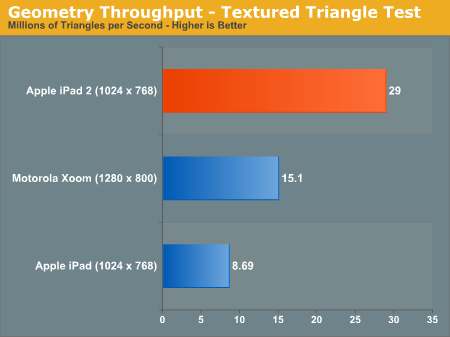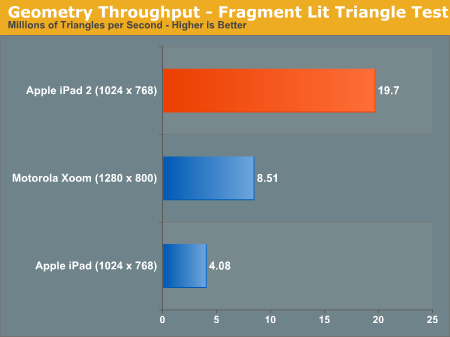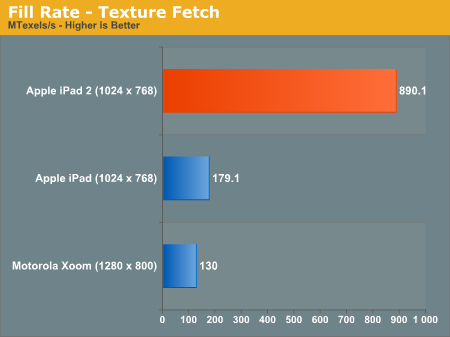Apple iPad 2 GPU Performance Explored: PowerVR SGX543MP2 Benchmarked
by Anand Lal Shimpi on March 12, 2011 3:04 PM EST- Posted in
- Smartphones
- Apple
- iPad
- GLBenchmark
- iPad 2
- Mobile
- Tablets
Earlier this morning we published our first impressions on Apple's iPad 2, including analysis on camera quality and a dive into the architecture behind Apple's A5 SoC. Our SoC investigation mostly focused on CPU performance, which we found to be a healthy 50% faster than the A4 in the original iPad - at least in web browsing. We were able to exceed Apple's claim of up to 2x performance increase in some synthetic tests, but even a 50% increase in javascript and web page loading performance isn't anything to be upset about. We briefly touched on the GPU: Imagination Technologies' PowerVR SGX 543MP2. Here Apple is promising up to a 9x increase in performance, but it's something we wanted to investigate.
Architecturally the 543MP2 has more than twice the compute horsepower of the SGX 535 used in Apple's A4. Each shader pipeline can execute twice the number of instructions per clock as the SGX 535, and then there are four times as many pipes in an SGX 543MP2 as there are in a 535. There are also efficiency improvements as well. Hidden surface removal works at twice the rate in the 543MP2 as it did in the 535. There's also a big boost in texture filtering performance as you'll see below.
As always we turn to GLBenchmark 2.0, a benchmark crafted by a bunch of developers who either have or had experience doing development work for some of the big dev houses in the industry. We'll start with some of the synthetics.
Over the course of PC gaming evolution we noticed a significant increase in geometry complexity. We'll likely see a similar evolution with games in the ultra mobile space, and as a result this next round of ultra mobile GPUs will seriously ramp up geometry performance.
Here we look at two different geometry tests amounting to the (almost) best and worst case triangle throughput measured by GLBenchmark 2.0. First we have the best case scenario - a textured triangle:

The original iPad could manage 8.7 million triangles per second in this test. The iPad 2? 29 million. An increase of over 3x. Developers with existing titles on the iPad could conceivably triple geometry complexity with no impact on performance on the iPad 2.
Now for the more complex case - a fragment lit triangle test:

The performance gap widens. While the PowerVR SGX 535 in the A4 could barely break 4 million triangles per second in this test, the PowerVR SGX 543MP2 in the A5 manages just under 20 million. There's just no competition here.
I mentioned an improvement in texturing performance earlier. The GLBenchmark texture fetch test puts numbers to that statement:

We're talking about nearly a 5x increase in texture fetch performance. This has to be due to more than an increase in the amount of texturing hardware. An improvement in throughput? Increase in memory bandwidth? It's tough to say without knowing more at this point.
| Apple iPad vs. iPad 2 | ||||
| Apple iPad (PowerVR SGX 535) | Apple iPad 2 (PowerVR SGX 543MP2) | |||
| Array test - uniform array access |
3412.4 kVertex/s
|
3864.0 kVertex/s
|
||
| Branching test - balanced |
2002.2 kShaders/s
|
11412.4 kShaders/s
|
||
| Branching test - fragment weighted |
5784.3 kFragments/s
|
22402.6kFragments/s
|
||
| Branching test - vertex weighted |
3905.9 kVertex/s
|
3870.6 kVertex/s
|
||
| Common test - balanced |
1025.3 kShaders/s
|
4092.5 kShaders/s
|
||
| Common test - fragment weighted |
1603.7 kFragments/s
|
3708.2 kFragments/s
|
||
| Common test - vertex weighted |
1516.6 kVertex/s
|
3714.0 kVertex/s
|
||
| Geometric test - balanced |
1276.2 kShaders/s
|
6238.4 kShaders/s
|
||
| Geometric test - fragment weighted |
2000.6 kFragments/s
|
6382.0 kFragments/s
|
||
| Geometric test - vertex weighted |
1921.5 kVertex/s
|
3780.9 kVertex/s
|
||
| Exponential test - balanced |
2013.2 kShaders/s
|
11758.0 kShaders/s
|
||
| Exponential test - fragment weighted |
3632.3 kFragments/s
|
11151.8 kFragments/s
|
||
| Exponential test - vertex weighted |
3118.1 kVertex/s
|
3634.1 kVertex/s
|
||
| Fill test - texture fetch |
179116.2 kTexels/s
|
890077.6 kTexels/s
|
||
| For loop test - balanced |
1295.1 kShaders/s
|
3719.1 kShaders/s
|
||
| For loop test - fragment weighted |
1777.3 kFragments/s
|
6182.8 kFragments/s
|
||
| For loop test - vertex weighted |
1418.3 kVertex/s
|
3813.5 kVertex/s
|
||
| Triangle test - textured |
8691.5 kTriangles/s
|
29019.9 kTriangles/s
|
||
| Triangle test - textured, fragment lit |
4084.9 kTriangles/s
|
19695.8 kTriangles/s
|
||
| Triangle test - textured, vertex lit |
6912.4 kTriangles/s
|
20907.1 kTriangles/s
|
||
| Triangle test - white |
9621.7 kTriangles/s
|
29771.1 kTriangles/s
|
||
| Trigonometric test - balanced |
1292.6 kShaders/s
|
3249.9 kShaders/s
|
||
| Trigonometric test - fragment weighted |
1103.9 kFragments/s
|
3502.5 kFragments/s
|
||
| Trigonometric test - vertex weighted |
1018.8 kVertex/s
|
3091.7 kVertex/s
|
||
| Swapbuffer Speed |
600
|
599
|
||
Enough with the synthetics - how much of an improvement does all of this yield in the actual GLBenchmark 2.0 game tests? Oh it's big.











219 Comments
View All Comments
xype - Sunday, March 13, 2011 - link
Heh, that's starting to sound like a running gag. "Android: 6-12 months down the line, it will be Much Better™."Well, duh. Apple gets ahead every time they release a product, be it phone or tablet. None of the average consumers will ever care about Android if _right now_ it's not competitive and whatever Apple sells in their store is better than whatever Android vendors are selling.
Sure, yeah, 2-3 years down the road, Android devices will totally dominate the iPad 2. But something tells me that won't be what Apple will be selling at that point.
mrdeez - Sunday, March 13, 2011 - link
Like I said, Android will catch up and surpass apple. Apple is hindered by their closed system and marriage to itunes. I don't deny the ipad2 is a great device I just dont like any company forcing their policies on me.I use the current android phone domination as an example.
Android will dominate sooner than that but that is not my reason for wanting the xoom. I believe the ipad to be more of a casual CE and the xoom(and devices that use android) more professional.
Do I ant Apple to fail, NO!
I
jharper12 - Saturday, March 12, 2011 - link
Not really sure why Android folks get their panties in a bunch over stuff like this. I'm an Android user, and I'm thrilled every time Apple raises the bar. Tegra 3 is due out in August (allegedly) and is supposed to be five times as powerful as Tegra 2. Tegra 2 had the advantage for a time, now it got crushed. If we actually see Tegra 3 by the end of the year, hopeful here but not holding my breath, then Android tablets will have the performance advantage for 3-6 months. We're also not going to get a super high resolution display until Apple does it, so again, be thankful when Apple pushes other hardware companies to kick it up a notch. One thing's for sure, these benchmarks seem to indicate the iPad 3 will be able to push all those pixels around, pretty impressive stuff.ncb1010 - Saturday, March 12, 2011 - link
Define super high resolution display? Android was leading the iPhone by a wide margin in pixel density until 8 months ago. Same thing is happening with tablets. 30% more pixels on the xoom in practically the same surface area.jharper12 - Saturday, March 12, 2011 - link
Super high resolution = 2048 x 1536. Although I'd also accept 1920 x 1440 or 1920 x 1200. Yep, the Xoom has a higher resolution display, definitely a brilliant thing. I certainly wouldn't want to pay $500 for 1024 x 768, but 1280 x 800 is palatable. Personally I bought a Nook Color and a 32GB class 10 microsd card, for a total of $299. Sitting this gen out with a cheap alternative, power and resolution are going to see a serious bump in about a year.Yes, a myriad of manufacturers do eventually offer higher resolutions on the Android platform, but typically as screen makers come out with new products. Apple literally has a spec in mind, and finds a supplier that wants to reap the benefits of hundreds of millions in sales from a single company. See the difference?
It's widely rumored and entirely likely that the next iPad will have a resolution of 2048 x 1536. Any another manufacturer can match this, but it'll cost them more than it'll cost Apple. I've said in the past, and I'll say it again, Apple's real advantage is that they know they'll order 10 million of whatever they are making. When you can buy in that volume, you can get a 2048 x 1536 screen made that nobody else has widely available yet for an extremely competitive price. Think about it, that represents hundreds of millions of dollars for a screen manufacturer... it gives them the ability to start a new product line without any risk at all, the only downside being that all of their capacity will be taken up by one customer for a significant period of time.
Again, no need to get touchy or defensive. There's simply no denying that Apple can purchase in greater volumes with less risk than pretty much anyone else... although maybe Microsoft will be a resolution winner in the near future, Nokia is a serious hardware powerhouse.
ncb1010 - Sunday, March 13, 2011 - link
Apply the Apple Tax and it all evens out...lower component costs or not. A lot of these tablet manufacturers have their own display divisions and so the point about Apple being able to dictate what type of screens people make is really moot.solipsism - Sunday, March 13, 2011 - link
You’re referring to less than accurate sub-pixel counting on AMOLED displays. Not exactly a slam dunk.So it’s been almost a year since the 326ppi iPhone 4 display was demoed. Where are the competing displays? Why doesn’t the iPhone 4 have a bad rap for rendering graphics with 4x the pixels of the original iPhone when the 23% higher pixel number is being stated as being the reason why the iPad 2 kicks its ass so thoroughly and why the iPad 1 is right on its ass?
Juzcallmeneo - Sunday, March 13, 2011 - link
Retina is nice, Super AMOLED is gorgeous.. and Super AMOLED Plus is cleaner, brighter, and lower power usage (Supposedly). I wish a tablet would have that for a screen. Samsung makes Apple's A5..why can't they put that screen on it?ncb1010 - Saturday, March 12, 2011 - link
Do a benchmark that uses more than 512 mb of VRAM and watch iPad 2's score crash.rish95 - Saturday, March 12, 2011 - link
Uhh...more than 512MB VRAM on a display like that? Never ever gonna happen..unless you're playing Crysis 2. To use over 512MB in most titles you need to hit 1680 x 1050 or even 1920 x 1080.